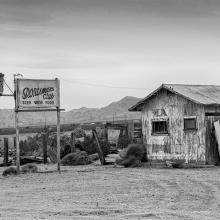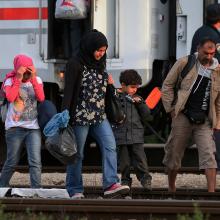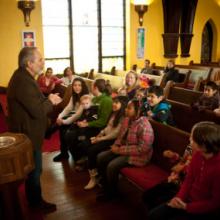migration
Mexican American writers render their world — unrecognized and illegible — visible and legitimate.
Much like Isaac from the book of Genesis, I am the son of a family seemingly destined to transience.
These retablos reflect on the faith that people had to begin the journey of migration, entering a foreign land. Often leaving family and home into the unknown, on a journey that is fraught with peril but also promise. Young fathers and mothers, children of families who will pray for them daily as they go. As the exhibit description mentioned, these retablos "depict a side of migration usually not told in statistical reports or even in detailed interviews of migrants."
Pope Francis said an open-air Mass before a huge crowd on Sunday to wrap up a jamboree of Catholic youth, the last big event before he returns to Rome to prepare for a historic trip to the Arabian Peninsula in one week.
Pope Francis wasted no time wading in on the standoff over funding for a U.S.-Mexico border wall on Wednesday as he started his trip to Panama, saying on the plane from Rome that hostility to immigrants was driven by irrational fear.
Twelve days before Christmas, 7-year-old Jakelin Amei Rosmery Caal Maquin died from dehydration eight hours after she was apprehended by border patrol. While this is a horrible tragedy, the harrowing truth is that that her death (and the deaths of many other migrants) is the logical outcome of our nation’s immigration policy decisions. According to an unclassified government report obtained by ABC News, Maquin’s death appears to have been one of four people who died this crossing the border month, and one of more than 260 this year.
When I landed at the airport in Brownsville, Texas, the Border Patrol was visibly present. I was suddenly reminded of my ancestors who were also greeted by “border patrol” while fleeing from the brutal chattel slavery in the southern states and making their way north – even all the way to Canada.
In March, the Trump administration added a question about citizenship to the 2020 Census. Multiple lawsuits have been brought against this addition. The last time some form of citizenship question was asked on the census was 1950. If this question wasn’t asked for six consecutive censuses, then why is the Trump administration pushing to reinstate it now?

Abandoned diner along highway The Grapes of Wrath's "Mother road," Route 66 in Mojave desert on April 6, 2010. Rolf_52 / Shutterstock.com
Seventy-eight years ago, John Steinbeck published The Grapes of Wrath. It’s since become a staple in high-school curricula, offering a glimpse into our nation’s troubled history. But its lessons are just as applicable today in our hyper-polarized climate, in which empathy is often found lacking.

Image via REUTERS/Alessandro Bianchi/RNS
Pope Francis has called on European leaders not to turn their back on refugees and migrants despite the cultural and security challenges associated with the arrival of 1 million people this past year. Francis has made concern for migrants a centerpiece of his papacy, and on Jan. 11 in his annual address to diplomats accredited to the Holy See he again urged governments to “overcome the inevitable fears associated with this massive and formidable phenomenon.”

Syrian refugee family in Croatia, Sept. 17. Photoman29 / Shutterstock.com
If Donald Trump had been Pharaoh of Egypt, the Holy Family never would have escaped from Herod’s persecution. Jews would have been prohibited from entering the country. Christmas features the story of a family from the Middle East leaving a homeland in fear and seeking refuge is a foreign land, just as millions do today.
If you visit Egypt and its ancient Coptic Church, you’ll see images of the Holy Family everywhere: Joseph, Mary — always on a donkey — and the infant Jesus. They are moving, wandering. You’ll find pictures of them passing by the pyramids. Egyptian Christians treasure this story for theirs is the land that offered welcome and hospitality to the Son of God when he was a refugee.

Image via caesart / Shutterstock
My thoughts go to the recent perilous journey of a close Iraqi friend — I will call him Mohammed — and his son, whom I will call Omar. Already the survivor of an assassination attempt, this trusted translator, driver, guide, and confidant received a death threat in early August. He fled under cover of night, taking Omar with him. On that same day, 15 men were kidnapped in his village. He left behind a wife and six other children.
From Baghdad, Mohammed and Omar fled to Kurdistan and into Turkey. Next they boarded a boat from Turkey to a series of Greek islands, where, much to their relief, they were at last able to get on a ferry to Athens.
Mohammed wrote letters throughout his journey. The messages that came were understandably brief. I often did not know what to advise him. But having lived with this dear family, I felt as if I were on the hazardous and exhausting 42-day journey with them.
What follows are excerpts from those letters.

Sunset over the dome of Saint Peter's Basilica in Vatican City. Photo via Vladimir Wrangel / Shutterstock.com
On July 21 and 22, the Vatican hosts two conferences on human trafficking and climate change, bringing the mayors of major cities — including several in the U.S. — to Rome for the events. What do human trafficking and climate change have to do with each other? And what does Catholicism have to do with them? Let us explain.
Q: Why is the Vatican concerned with human trafficking and climate change?
A: If Pope Francis has two pet issues, they are human trafficking and climate change. Since the first year of his papacy he has spoken against human trafficking, calling it “a crime against humanity” and lamenting it as modern slavery. It’s an even bet that when the pope addresses the United Nations in late September he will hammer it as one of the crucial issues of our time. Ditto on climate change. In June, the pontiff published his encyclical — the highest teaching of the church — on climate change.
“Our home is being ruined and that hurts everyone, especially the poorest among us,” Francis said just before the publication of the encyclical.
Pope Francis on Wednesday said people who shut out refugees should seek forgiveness, after clashes on Italy’s borders as European countries try to push back against a wave of migrants fleeing by boat from Libya.
Addressing crowds in St. Peter’s Square, Francis drew his followers’ attention to the U.N.’s World Refugee Day this Saturday.
Central America needs help expanding education opportunities, building child welfare systems, and sheltering victims of violence and witnesses to crime. But none of these reforms can be sustained unless Central American governments also work to eradicate corruption and reform their judicial systems.
As Romero said during a time of similar urgency, “On this point there is no possible neutrality. We either serve the life of Salvadorans or we are accomplices in their death. … We either believe in a God of life or we serve the idols of death.”
THROUGH THEIR EYES
In 2011, Raul Guerrero provided 100 Kodak disposable cameras and taught basic photography skills to nine young students in the Newlands area of Moshi, Tanzania. The Disposable Project book brings together their images of their community, with text by Guerrero. the-disposable-project.com
JOURNEYING
“Migration has been, for centuries, not only a source of controversy but a source of blessing,” Deirdre Cornell writes in Jesus Was a Migrant. Inspired by ministering among immigrants in different settings, this is a beautifully written set of deeply humanizing reflections on the immigrant experience and Christian spirituality. Orbis Books
“GOD CREATED the world and we created borders.”
That obvious recognition was shared at a recent consultation in Quito, Ecuador, between North American and Latin American churches on “Faith, Economy, and Migration.” Felipe Adolf, president of the Latin American Council of Churches, shared that conclusion on how issues of migration and reform are global and not just local.
It’s very easy to see the problems confronting our nation and feel as though the challenges facing the rest of the world are simply too much to bear. Continuing poverty and unemployment, discrimination of all kinds, and wars and rumors of wars fill our newsfeeds, papers, and TV screens. But it’s naïve and narrow to think this way. Many of the threats we face are global in nature and don’t know any boundaries. Through our economies and consumption habits, media, travels and migrations, and for Christians in particular our faith, we are inextricably connected with men and women around the world. It’s always been important, but now especially so, to think globally when it comes to faith and justice.
Sojourners has a long history of doing this very thing. We started as a little group of two kinds of people—those who had grown up conservative evangelicals and were deeply frustrated with the lack of attention to issues of justice and peace, and those who had just come to faith from the student movements and counterculture of the 1960s and ’70s. We met at Trinity Evangelical Divinity School and began to study and pray through the scriptures about injustice, war, and poverty. The Vietnam War was raging, and we were looking for a biblical understanding of the events of our time.
As Congress makes a final attempt this fall to act on comprehensive immigration reform, the debate is focusing on “securing” our borders and offering a path to citizenship to the 11 million residents here without proper documentation. These politicized arguments, however, don’t see the forest for the trees.
We’re not viewing the broader impact that immigration has had on American society, especially since the last major immigration reform of the 1960s. In particular, we’re missing the way immigration is transforming the religious life of North America.
We commonly view immigration as introducing large numbers of non-Christian religions into U.S. society. True, because of immigration in the last half century, America has become the most religiously diverse country in the world, with thousands of mosques and temples dotting our religious landscape.
ONE OF THE most well-known and revered icons today is Andrei Rublev’s reflection on the Holy Trinity, painted between 1422 and 1425 in Russia. It depicts three angels seated around a table that bears a chalice. The female figures form a circle evoking deep mutuality, interconnectedness, and love between one another. But the circle is open, inviting the world into this profound experience of community. As Christine Challiot, an Eastern Orthodox laywoman, wrote, “Rublev painted the three angels with a circular motion to signify their unity and equality, ‘thus creating a unity to represent the Holy Trinity in its movement of love.’”
This profound reflection is set in the biblical context of giving hospitality to the stranger. The icon depicts the story of the hospitality offered by Abraham and Sarah in Genesis 18:1-15 to three strangers. Abraham rushed to offer them hospitality—water and food.
The three migrating strangers are messengers of God. The text says simply that they were the Lord; interpreters see the three as the presence of the Trinity. And they, in turn, bring an announcement that Sarah, in her old age, will bear a son, fulfilling God’s promises. Sarah and Abraham suddenly find the tables reversed, and they are the guests at God’s table, being invited into this community of love. Thus, Catholic theologian Elizabeth Johnson explains, “This is a depiction of a trinitarian God capable of immense hospitality who calls the world to join the feast.”
This biblical story is a declaration of the unexpected, life-giving presence of God, discovered through providing hospitality to strangers. Rabbi Jonathan Sacks notes that the love of strangers is declared 36 times in the Hebrew scriptures, as opposed to the love of neighbor, mentioned only once. The love of strangers and sojourners is a primary test of one’s love for God; this is linked to the presence of migrating people, with whom we can unexpectedly encounter God in fresh and promising ways that open the future to new possibilities.
MARTA AND LUISA had always fantasized about leaving their small town in northern Mexico to become dancers in a big city.
As the teenage sisters sat in the bed of a rusted pickup truck speeding toward the U.S. border, they thought their dreams would soon become reality. After sunset, the truck screeched to an abrupt stop. A middle-aged man with a skeleton tattoo on his arm hopped out of the driver’s seat, gritted his yellow teeth, and mumbled, “Vamos.” The time had come to complete the journey by foot.
Marta and Luisa walked closely behind the man and his two associates for hours along the desert paths they believed led to a brighter future. When they crossed the border into Arizona at about midnight, the tattooed man forcefully grabbed 16-year-old Marta and separated her from her older sister.
He explained that although he previously offered to help the girls cross the border for a small fee, the transportation cost had risen. Now Marta would have to work to pay off her debt. Alone.
Cecilia Hilton Gomez, director of Hispanic outreach programs for Free for Life International, describes the way that many human traffickers prey on vulnerable girls hoping to emigrate to the United States from Mexico and other parts of Central America. Since girls like Marta often have little education, lack formal paperwork, and have no knowledge of English, they become prime targets for traffickers looking to profit by selling women to brothel owners in the U.S.
“This is an epidemic, and it’s increasing,” Gomez states. “A lot of people think slavery has been gone for years, but it’s one of the largest criminal enterprises that exists now, and it’s right here in America.”












